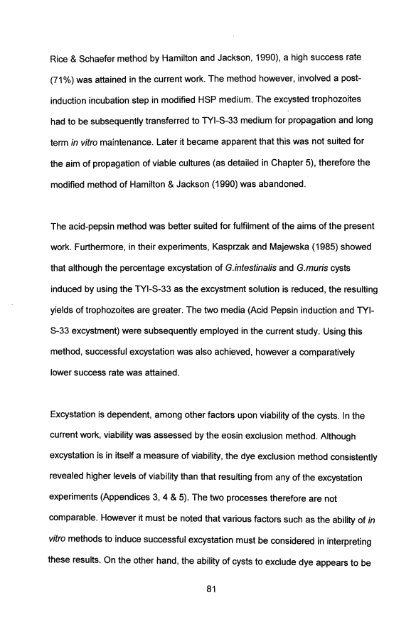in vitro culture and isoenzyme analysis of giardia lamblia
in vitro culture and isoenzyme analysis of giardia lamblia
in vitro culture and isoenzyme analysis of giardia lamblia
You also want an ePaper? Increase the reach of your titles
YUMPU automatically turns print PDFs into web optimized ePapers that Google loves.
Rice & Schaefer method by Hamilton <strong>and</strong> Jackson, 1990), a high success rate<br />
(71 %) was atta<strong>in</strong>ed <strong>in</strong> the current work. The method however, <strong>in</strong>volved a post<strong>in</strong>duction<br />
<strong>in</strong>cubation step <strong>in</strong> modified HSP medium. The excysted tropholoites<br />
had to be subsequently transferred to TYI-S-33 medium for propagation <strong>and</strong> long<br />
term <strong>in</strong> <strong>vitro</strong> ma<strong>in</strong>tenance. Later it became apparent that this was not suited for<br />
the aim <strong>of</strong> propagation <strong>of</strong> viable <strong>culture</strong>s (as detailed <strong>in</strong> Chapter 5). therefore the<br />
modified method <strong>of</strong> Hamilton & Jackson (1990) was ab<strong>and</strong>oned.<br />
The acid-peps<strong>in</strong> method was better suited for fulfilment <strong>of</strong> the aims <strong>of</strong> the present<br />
work. Furthermore, <strong>in</strong> their experiments, Kasprzak <strong>and</strong> Majewska (1985) showed<br />
that although the percentage excystation <strong>of</strong> G.<strong>in</strong>test<strong>in</strong>alis <strong>and</strong> G.muris cysts<br />
<strong>in</strong>duced by us<strong>in</strong>g the TYI-S-33 as the excystment solution is reduced, the result<strong>in</strong>g<br />
yields <strong>of</strong> tropholoites are greater. The two media (Acid Peps<strong>in</strong> <strong>in</strong>duction <strong>and</strong> TYI<br />
S-33 excystment) were subsequently employed <strong>in</strong> the current study. Us<strong>in</strong>g this<br />
method, successful excystation was also achieved, however a comparatively<br />
lower success rate was atta<strong>in</strong>ed.<br />
Excystation is dependent, among other factors upon viability <strong>of</strong> the cysts. In the<br />
current work, viability was assessed by the eos<strong>in</strong> exclusion method. Although<br />
excystation is <strong>in</strong> itself a measure <strong>of</strong> viability, the dye exclusion method consistently<br />
revealed higher levels <strong>of</strong> viability than that result<strong>in</strong>g from any <strong>of</strong> the excystation<br />
experiments (Appendices 3,4 & 5). The two processes therefore are not<br />
comparable. However it must be noted that various factors such as the ability <strong>of</strong> <strong>in</strong><br />
<strong>vitro</strong> methods to <strong>in</strong>duce successful excystation must be considered <strong>in</strong> <strong>in</strong>terpret<strong>in</strong>g<br />
these results. On the other h<strong>and</strong>, the ability <strong>of</strong> cysts to exclude dye appears to be<br />
81
















